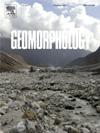Meteorological factors control debris slides and debris flows in a high-Arctic glacier basin (Ny-Ålesund, Svalbard)
IF 3.1
2区 地球科学
Q2 GEOGRAPHY, PHYSICAL
引用次数: 0
Abstract
Landslide processes are one of the dominant agents of erosion and sediment transport on sediment-mantled slopes in arctic environments. Increased landslide activity is anticipated as climate change is projected to decrease mountain slope stability. High-Arctic environments, such as Svalbard, serve as crucial observatories for investigating current and future slope dynamics within a changing climate, particularly due to arctic amplification effects. Despite the significance of Arctic regions, empirical evidence in high latitudes is often lacking. This scarcity can be attributed to the absence of long-term, high-resolution terrain data with sufficient temporal resolution to assess the impact of meteorological boundary conditions on landscapes altered by climate change. However, addressing this gap in empirical evidence is essential for understanding the complex interplay between meteorological variables and debris slide and debris flow evolution in Arctic environments. This study presents a unique high-resolution remote sensing dataset within a high-Arctic glacier basin acquired over a 10-year period. Through the combination of terrestrial laser-scanning and an autonomous camera network, we were able to investigate the impact of meteorological boundary conditions on the trigger mechanisms of translational debris slides and debris flows and unravel paraglacial slope evolution following recent glacier retreat on the example of the Austre Lovénbreen glacier basin (Svalbard, Norway). Translational debris slides accounted for approximately 96 % (N = 147) of the total sediment flux observed, with debris flows (N = 21) acting as a secondary agent of sediment transport. The debris slide activity significantly increased between 2011 and 2021. Heavy rainfall events primarily influence the frequency and magnitude of debris slides during the hydrological summer, while the duration and intensity of the thawing period serve as the principal control for their initiation. Furthermore, a 2-year recurrence period for major debris flows (≥ 400 m3) was found, which is about 2.5 to 5 times shorter than previous estimates for the last few decades on Svalbard. In conclusion, this study highlights the impact of meteorological factors on debris slide frequency and magnitude within high-Arctic glacier basins, shedding light on the dynamics of paraglacial slope modification in Arctic environments affected by climate change.
控制北极高纬度冰川盆地(斯瓦尔巴特群岛尼-奥勒松)碎屑滑坡和碎屑流的气象因素
滑坡过程是北极环境中沉积物覆盖斜坡上侵蚀和沉积物迁移的主要因素之一。由于气候变化预计会降低山坡的稳定性,因此预计滑坡活动将会增加。斯瓦尔巴群岛等北极高纬度环境是研究气候变化下当前和未来山坡动态的重要观测站,特别是由于北极放大效应。尽管北极地区非常重要,但高纬度地区往往缺乏经验证据。这种缺乏可归因于缺乏具有足够时间分辨率的长期、高分辨率地形数据,以评估气象边界条件对因气候变化而改变的地貌的影响。然而,要了解北极环境中气象变量与泥石流演变之间复杂的相互作用,解决这一经验证据方面的差距至关重要。本研究展示了一个独特的高分辨率遥感数据集,该数据集是在一个高纬度北极冰川盆地内历时 10 年采集的。通过地面激光扫描和自主相机网络的结合,我们得以研究气象边界条件对平移碎屑滑坡和碎屑流触发机制的影响,并以奥斯特勒洛韦布林冰川盆地(挪威斯瓦尔巴群岛)为例,揭示了近期冰川退缩后的副冰川斜坡演变。在观测到的沉积物总通量中,平移式泥石流约占 96%(N = 147),泥石流(N = 21)是沉积物迁移的次要媒介。2011 年至 2021 年期间,泥石流活动明显增加。暴雨事件主要影响夏季水文过程中泥石流的发生频率和规模,而解冻期的持续时间和强度则是泥石流发生的主要控制因素。此外,研究还发现,主要泥石流(≥ 400 立方米)的重现期为 2 年,比过去几十年斯瓦尔巴群岛泥石流重现期的估计值短 2.5 到 5 倍。总之,这项研究强调了气象因素对北极高纬度冰川盆地内泥石流发生频率和规模的影响,揭示了受气候变化影响的北极环境中副冰川斜坡改变的动态。
本文章由计算机程序翻译,如有差异,请以英文原文为准。
求助全文
约1分钟内获得全文
求助全文
来源期刊

Geomorphology
地学-地球科学综合
CiteScore
8.00
自引率
10.30%
发文量
309
审稿时长
3.4 months
期刊介绍:
Our journal''s scope includes geomorphic themes of: tectonics and regional structure; glacial processes and landforms; fluvial sequences, Quaternary environmental change and dating; fluvial processes and landforms; mass movement, slopes and periglacial processes; hillslopes and soil erosion; weathering, karst and soils; aeolian processes and landforms, coastal dunes and arid environments; coastal and marine processes, estuaries and lakes; modelling, theoretical and quantitative geomorphology; DEM, GIS and remote sensing methods and applications; hazards, applied and planetary geomorphology; and volcanics.
 求助内容:
求助内容: 应助结果提醒方式:
应助结果提醒方式:


